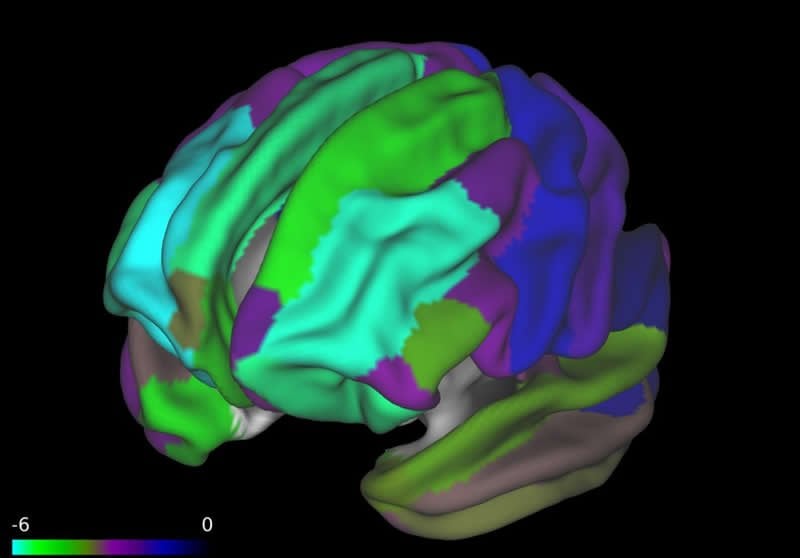Summary: Obese children tend to have a thinner prefrontal cortex and cerebral cortex. The findings could explain why there is a correlation between obesity in children and decreased executive function.
Source: University of Vermont
Published studies have long found a correlation between obesity in children and decreased executive function. New research published in JAMA Pediatrics, based on data mined from a massive national research study, suggests that a change in brain structure – a thinner prefrontal cortex – may help explain that interrelationship.
“Our results show an important connection; that kids with higher BMI tend to have a thinner cerebral cortex, especially in the prefrontal area,” said Jennifer Laurent, an associate professor in the Department of Nursing at the University of Vermont and lead author of the study.
The findings are based on data retrieved from a National Institutes of Health-funded research project, the Adolescent Brain Cognitive Development study, or ABCD, which is following 10,000 teens over a 10 year period. Every two years, study subjects are interviewed, take a battery of tests, give blood samples and undergo brain scans.
The study analyzed results from 3,190 nine- and 10-year-olds recruited at 21 ABCD sites in 2017.
The robust study confirmed the findings of its predecessors; that subjects with higher BMI tended to have lower working memory, as measured by a list sorting test.
But it added an important component to that insight – a physiological correlate in the brain that might help explain the connection.
“Our hypothesis going into the study was that the thickness of the cerebral cortex would ‘mediate’ – or serve as an explanatory link for – the relationship between BMI and executive function,” Laurent said.
The findings did confirm the relationship, according to the study’s senior author, Scott Mackey, an assistant professor of psychiatry in the University of Vermont’s Larner College of Medicine.
“We found widespread thinning of cerebral cortex” among research subjects with higher BMI”, Mackey said, “but especially so in the prefontal area.”
“That’s significant because we know that executive function, things like memory and the ability to plan, are controlled in that area of the brain,” he said.
More research is needed to determine the nature of the link between the three variables.
“It could be that a thinner prefrontal cortex is affecting decision-making in some children, and they make unhealthy dietary choices as a result, which could lead to obesity,” Laurent said.

Or the causal relationship could work in the opposite direction.
“We know from rodent models and adult studies that obesity can induce low grade inflammatory effects, which actually do alter cellular structure” and can lead to cardiovascular disease, Laurent said.
“With prolonged exposure to obesity, it is possible that children have chronic inflammation, and that may actually be affecting their brain in the long term,” she said.
If that were the case, there would be significant public health implications, Laurent said. “We would want to proactively encourage changes in kids’ diets and exercise levels at a young age with the understanding that it’s not only the heart that is being affected by obesity, it is perhaps also the brain.”
The decrease in working memory was a statistical observation, Laurent said, not a clinical one.
“We did not look at behavior. It’s very important that this work not further stigmatize people who are obese or overweight,” she said.
“What we’re saying is that, according to our measures, we are seeing something that bears watching. How and if it translates to behavior is for future research to determine.”
Data analysis for the study was done at the University of Vermont and Yale University. Richard Watts, director at the FAS Brain Imaging Center and research associate professor of radiology at Yale, was a co-author of the study.
Source:
University of Vermont
Media Contacts:
Jeff Wakefield – University of Vermont
Image Source:
The image is credited to Yale University.
Original Research: Closed access
“Associations Among Body Mass Index, Cortical Thickness, and Executive Function in Children”. Jennifer Laurent et al.
JAMA Pediatrics doi:10.1001/jamapediatrics.2019.4708.
Abstract
Associations Among Body Mass Index, Cortical Thickness, and Executive Function in Children
Importance
A total of 25.7 million children in the United States are classified as overweight or obese. Obesity is associated with deficits in executive function, which may contribute to poor dietary decision-making. Less is known about the associations between being overweight or obese and brain development.
Objective
To examine whether body mass index (BMI) is associated with thickness of the cerebral cortex and whether cortical thickness mediates the association between BMI and executive function in children.
Design, Setting, and Participants
In this cross-sectional study, cortical thickness maps were derived from T1-weighted structural magnetic resonance images of a large, diverse sample of 9 and 10-year-old children from 21 US sites. List sorting, flanker, matrix reasoning, and Wisconsin card sorting tasks were used to assess executive function.
Main Outcomes and Measures
A 10-fold nested cross-validation general linear model was used to assess mean cortical thickness from BMI across cortical brain regions. Associations between BMI and executive function were explored with Pearson partial correlations. Mediation analysis examined whether mean prefrontal cortex thickness mediated the association between BMI and executive function.
Results
Among 3190 individuals (mean [SD] age, 10.0 [0.61] years; 1627 [51.0%] male), those with higher BMI exhibited lower cortical thickness. Eighteen cortical regions were significantly inversely associated with BMI. The greatest correlations were observed in the prefrontal cortex. The BMI was inversely correlated with dimensional card sorting (r = −0.088, P < .001), list sorting (r = −0.061, P < .003), and matrix reasoning (r = −0.095, P < .001) but not the flanker task. Mean prefrontal cortex thickness mediated the association between BMI and list sorting (mean [SE] indirect effect, 0.014 [0.008]; 95% CI, 0.001-0.031) but not the matrix reasoning or card sorting task.
Conclusions and Relevance
These results suggest that BMI is associated with prefrontal cortex development and diminished executive functions, such as working memory.






